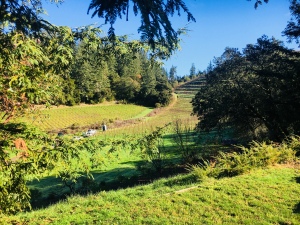
Napa
Winter may not be your first thought on a great time to visit Napa, but it’s definitely a good idea. Clear blue skies and 50-60 degree temperatures awaited us along with few crowds and fantastic wine. The vineyards are at one of their most peaceful moments with winter pruning just starting and workers starting to meander through the fields. Greenery has grown over many of the fire-topped hills making last fall’s vicious fires less evident and unless you know what to look for, it’s pretty hard to see any damage in the vineyards whatsoever.
Del Dotto Vineyards
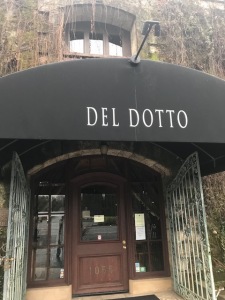 We kicked off our long weekend at Del Dotto which always gives a great tour with barrel tastings, good humor, and sumptuous wines. It’s also a terrific learning experience as the barrel tastings offer a glimpse into how different types of oak impact a wine’s development as well as how wine develops in general before it gets bottled.
We kicked off our long weekend at Del Dotto which always gives a great tour with barrel tastings, good humor, and sumptuous wines. It’s also a terrific learning experience as the barrel tastings offer a glimpse into how different types of oak impact a wine’s development as well as how wine develops in general before it gets bottled.
Some tasting highlights were the French oak aged 2015 Piazza Del Dotto Cabernet Sauvignon ($175) which was spicy, red/black fruit driven, and showing some cedar notes. Some of our group preferred its counterpart aged in American oak which had more pronounced vanilla and sweet spice flavors. This tour is also a fun way to better understand what tastes a group of people have and why as you get to compare the same wine side-by-side aged in different kinds of oak.
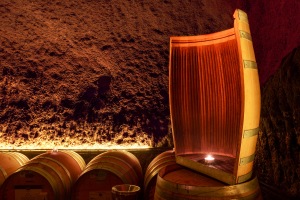
Barrel Staves
We also had an easy-drinking 2016 Sangiovese (the Italian owners understandably favor this grape as well as red in general) and it’s a reasonable value at $58. In addition, Del Dotto produces a well-made dessert wine called Dolores ($55) which is similar in style to a young Port and made predominantly from Cabernet Sauvignon grapes. Perfect with chocolate and truffles.
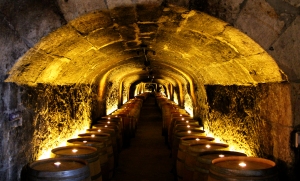
Old Caves
Del Dotto has a couple of locations but I prefer their Atlas Peak, Napa spot as it’s the historic cave and less opulent than the newer St. Helena location. It’s also a mere 15 minutes from downtown Napa which makes it convenient especially if you have to go back to your room to sleep off the many tastings this tour provides. The tour also includes pizza, cheese, and chocolate with the tastings which adds to its great value ($60/person during week and $75/person on weekends).
Turnbull Wine Cellars

Turnbull Tasting Room
I never thought riding an elevator would yield such rewards but after one of our Master of Wine student seminars last year, I got talking to the charismatic, hilarious, and extremely talented winemaker for Turnbull, Peter Heitz. I finally got the chance to pay him a visit in Oakville and try more of their terrific wines on this trip.
Peter explained the different soil types of the four vineyards Turnbull works with and what they, along with the site’s aspect and elevation, add to each wine. I’m a total soil geek and loved seeing the rock displays they had on hand, as it makes it even more evident how soils contribute different characteristics to each wine.

Turnbull soils
The soils at Turnbull include red volcanic rock (produces wines with minerality, ripe fruit, and concentration), alluvial soil (produces darker red fruit, spice box notes, and elegant early expression), clay loam (expresses in tart cherry flavors and dense red wines), and bale (produces strawberry/red fruit notes in red wines and mineral-driven Sauvignon Blanc).
The highlights for me were the 2016 Josephine Sauvignon Blanc ($44) which was vibrant with citrus, tart apple, and mineral notes on a textured palate. Their signature Cabernet Sauvignons were also excellent. The 2014 Fortuna Cabernet Sauvignon ($135), from alluvial soils, was alluring with black cherry, raspberry, spice, and dusty tannins, while the 2014 Black Label Cabernet Sauvignon ($150) was a haunting, powerful wine cast with dark fruit, nuanced layers, and a firm structure.
While these are obviously not everyday wines for most, the 2015 Reserve Cabernet Sauvignon ($85) is a more approachable offering. Blue and red fruit showcase this wine’s energetic length and verve.
Fisher Vineyards
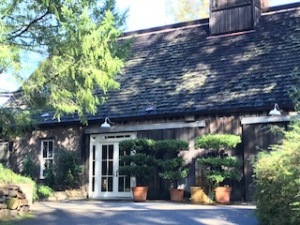
Fisher Vineyards
The next day we drove an hour up into Spring Mountain to visit Fisher, a wine I have had a few times and always enjoyed. Fisher’s location feels worlds away from Napa with its Douglas pines, angular slopes, and cool brisk air. Fittingly, the owner’s gorgeous Akita mountain dog Sake, (a gigantic but gentle giant) greeted us as we pulled in.
Founded in 1973 by Fred and Juelle Fisher, the winery is completely family-run with the Fisher children Whitney, Robert, and Cameron making, overseeing, and selling the wine respectively.
A small production winery, Fisher focuses on wine from single vineyards or blending wines through their various sites. We tried the following wines here:
2015 Mountain Estate Chardonnay ($75)– Aged 18 months in French oak, this was a robust style. Fresh minerality and zesty acidity framed ripe pear, lemon, and toasty crème brulee notes with a lingering finish and creamy palate.
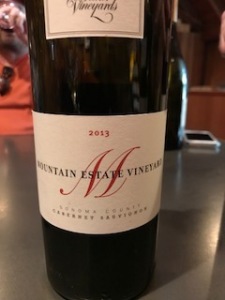 2013 Mountain Estate Cabernet Sauvignon ($95 and from Sonoma) – dark and brooding with concentrated blackberry, plum, and savory spice with a firm dense structure and lush finish. Made from 87% Cabernet Sauvignon, 6% Cabernet Franc, 6% Merlot, and 1% Syrah.
2013 Mountain Estate Cabernet Sauvignon ($95 and from Sonoma) – dark and brooding with concentrated blackberry, plum, and savory spice with a firm dense structure and lush finish. Made from 87% Cabernet Sauvignon, 6% Cabernet Franc, 6% Merlot, and 1% Syrah.
2014 Coach Insignia Cabernet Sauvignon ($110 and from Napa) – dense and powerful. Intense flavors of black/red cherry, leather, and licorice with a powerful long finish and vibrant acidity. This wine was already approachable although it will age another decade. Made from 80% Cabernet Sauvignon, 12% Merlot, and 8% Malbec.
2009 Wedding Vineyard Cabernet Sauvignon ($150) – from the
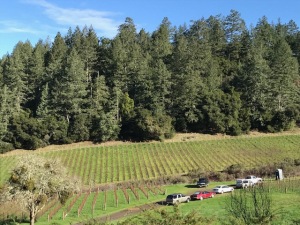
Wedding Vineyard
sloping vineyard where Fred and Juelle were married right next to the winery, this spellbinding wine is 78% Cabernet Sauvignon and 22% Cabernet Franc. This was my favorite of all with explosive flavors of brambly blackberry, cedar, pencil shavings, and forest floor cascading along a mineral-driven backbone and chewy tannins. This wine’s mountain terroir and site elevation of 1200 feet are evident in its power, elegance, and terse acidity.
Salvestrin Winery
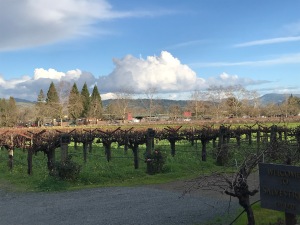
Salvestrin
Another first for me on this trip was getting to visit Salvestrin which is a wine I discovered at the Taj Campton hotel in San Francisco (a regular haunt for other pre-wine country visits). The bar there always has interesting and unusual wine finds. Salvestrin is also family-owned (in its fourth Italian generation) and located in the St. Helena A.V.A. (American Viticultural Area). Their wines manage to combine characteristics of lush valley fruit with the restraint and regality of mountain fruit.
We had a fantastic tasting here while overlooking their striking quadrilateral cordon-trellised vines. This setup allows the canopy to be split which allows filtered sunlight to get into the middle of the canopy (a common method in warmer climates). The first wine we tried was the 2016 Sauvignon Blanc ($25). Made in 50% neutral oak and 50% stainless steel, this wine was spritely and refreshing with mouth-filling texture and tropical fruit and pineapple notes.

Quadrilateral cordon vines
The next three wines were all from the historic Dr. Crane Vineyard. The 2015 Retaggio ($50) was an intriguing blend of 42% Sangiovese, 41% Cabernet Sauvignon, 10% Merlot, and 7% Cabernet Franc. Tasting of red and black fruit intermixed with Provence-style garrigue and spicy savory notes, tight structure and lively acid made this wine a lighter style of red.
The 2014 Cabernet Sauvignon ($64) is a blend of 92% Cabernet Sauvignon, 5% Merlot, and 3% Cabernet Franc and is a killer buy for a quality Napa Cabernet. Blackberry, cherry, tea, and vanilla flavors preceded concentrated coffee and cedar notes backed by fine-grained tannins and a long savory finish.
 The 2013 Three D Cabernet Sauvignon ($145) is 100% Cabernet Sauvignon and was recently released as it spent 34 months in 100% new French oak. Sustainable growing practices and rigorous selection make this wine a true standout (the “Three D” stands for the three Salvestrin daughters). This wine expressed intense aromas of tart black cherries, plums, and dried herbs while a velvet finish eased in seductive notes of sweet spice and earthy mineral notes.
The 2013 Three D Cabernet Sauvignon ($145) is 100% Cabernet Sauvignon and was recently released as it spent 34 months in 100% new French oak. Sustainable growing practices and rigorous selection make this wine a true standout (the “Three D” stands for the three Salvestrin daughters). This wine expressed intense aromas of tart black cherries, plums, and dried herbs while a velvet finish eased in seductive notes of sweet spice and earthy mineral notes.
We also got to try the 2014 Cabernet Franc, a real gem here, and a varietal I saw made in a 100% style more than I have on prior visits. The pepper, herbaceous, and inky violet tones of this variety can be incredibly seductive and haunting in the right hands as it is in this wine.
Incidentally, Salvestrin also has its own charming Inn at Salvestrin which features on-site accommodation right at the vineyard with gorgeous views and a short walk into St. Helena. There are few things better than waking up next to vineyards in my mind.
Merus Wines
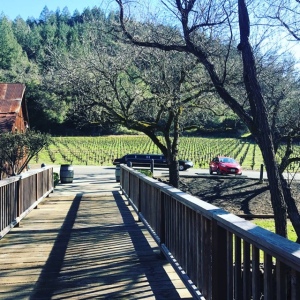
Merus
Our visit to the charmingly chic Merus took us to another idyllic location at the outer edges of St. Helena near Calistoga and Howell Mountain. Merus means “complete, undiluted, and pure” in Latin. This small production luxury wine was created in 1998 and continues to be a showstopper. In addition to Merus, their second label, Altvs, is also a stunner and was created in 2005. “ALT-US” means “noble and profound” in Latin.
We started our tasting with the 2014 Altvs Chardonnay ($40) which was an impeccably balanced wine that appealed to everyone in our group, even those that typically don’t like Chardonnay. Moderate in alcohol yet pleasantly weighty in body, this wine tasted of pear and lemon with a mineral core, steely acidity, and a long lush finish.
2013 Altvs ($75) is another great buy for a high-quality Napa Cabernet. Produced in small quantities by winemaker John Clews, Altvs combines fruit from mountain, hillside and benchland sites to create this concentrated beauty. This wine was laser-focused in its intensity with sustained black and red fruit, cassis, and sweet tobacco notes. Regal structure and fine-grained tannins made this wine approachable now but also allow for longer aging. 80% Cabernet Sauvignon and 20% Petit Verdot.
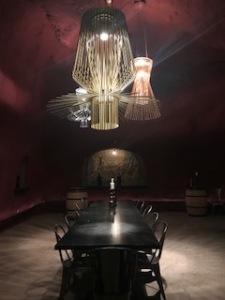
Merus Private Room
Next we tried the 2013 Merus ($160) which was a riveting blend of 85% Cabernet Sauvignon, 6% Petit Verdot, 6% Malbec, and 3% Merlot from the Coombsville A.V.A. (one of the coolest sites in Napa). Its longer growing season produces robust wines that are powerful yet still elegant like this one. This wine was rich in complexity with aromas of brambly blackberry, tarry minerality, violet, and bacon that introduced palate flavors of wet rock, black currant, and menthol.

Merus
This wine is carefully handled throughout its birth using whole-berries and warmer fermentation temperatures along with frequent punch-downs to yield ideal extraction without compromising the wine’s final balance. Separate vineyard lots are also maintained throughout fermentation as well as aging (done in individually-matched French oak for each lot) in order to create the optimal Merus blend each year. If you’re a points person, Robert Parker gave this wine 93 points.
If you do go to Napa, you’ll be pleasantly surprised with how much there is to do in the town itself. Napa has developed into a vibrant town with great restaurants, wine bars, eclectic shops, and a diverse hotel selection. We stayed at the Westin Verasa was which fantastic and a 5-min walk to Napa (right past the many delights of the Oxbow Public Market). We also found a great driving company in SafeRide Wine Tours owned by former Napa law enforcement officers – what could be safer than that?
